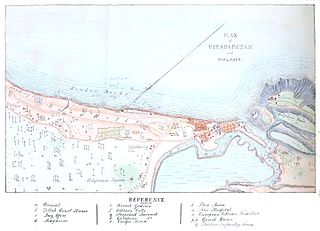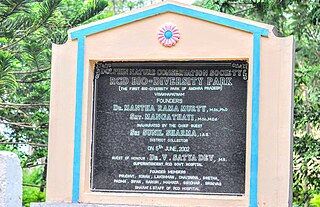
Visakhapatnam (; formerly known as Vizagapatam, also known as Vizag, Viśākha or Waltair is the largest and most populous metropolitan city in the Indian state of Andhra Pradesh. It is between the Eastern Ghats and the coast of the Bay of Bengal. It is the second largest city on the east coast of India after Chennai, and the fourth largest in South India. It is one of the four smart cities of Andhra Pradesh selected under the Smart Cities Mission and is the headquarters of Visakhapatnam district. Vizag is popularly knows as shipbuilding capital of India due to presence of multiple shipyard such as Hindustan Shipyard, Naval Dockyard and being the central naval command of the east coast.

The olive ridley sea turtle, also known commonly as the Pacific ridley sea turtle, is a species of turtle in the family Cheloniidae. The species is the second-smallest and most abundant of all sea turtles found in the world. L. olivacea is found in warm and tropical waters, primarily in the Pacific and Indian Oceans, but also in the warm waters of the Atlantic Ocean.
Gahirmatha Beach is a beach in Kendrapara district of the Indian state of Odisha. The beach separates the Bhitarkanika Mangroves from the Bay of Bengal and is the world's most important nesting beach for olive ridley sea turtles. The beach is part of Gahirmatha Marine Wildlife Sanctuary, which also includes the adjacent portion of the Bay of Bengal.

(Bheemunipatnam ), is a suburb of Visakhapatnam, India. The town was named after Bhima, a character in the Hindu epic Mahabharata. It was formerly administered under the Bheemunipatnam municipality but merged into GVMC in 2017. It is currently under the administration of Bheemunipatnam Revenue Division and its headquarters is at Bheemunipatnam.

Hope Island(Krachchu Lanka)is a small tadpole shaped Island situated off the coast of Kakinada, India, in the Bay of Bengal.

Thotlakonda Buddhist Complex is situated on a hill near Bheemunipatnam about 15 kilometres (9.3 mi) from Visakhapatnam in Andhra Pradesh, India. The hill is about 128 metres (420 ft) above sea level and overlooks the sea. The Telugu name Toṭlakoṇḍa derived from the presence of a number of rock-cut cisterns hewn into the bedrock of the hillock. In 2019, the stupa was partially damaged due to monsoons, but it was restored by 2021 at the cost of Rs 42 lakh.

Madhurawada is a major business and residential area of Visakhapatnam in the state of Andhra Pradesh. It is located on the Visakhapatnam-Vizianagaram stretch of National Highway 16 around 16 km from the city center of Visakhapatnam.

Simhadri Super Thermal Power Plant is a coal-fired power plant located in the outskirts of Visakhapatnam city in the Indian state of Andhra Pradesh. The power plant is one of the coal fired power plants of NTPC, a Government of India enterprise. The coal for the power plant is sourced from Kalinga Block of Talcher Coal fields in Odisha. The plant is a national asset, and power generated is shared between multiple states, as the operator is national. Power generated by units 1 and 2, making up for 1,000 MW, is dedicated to power distribution companies owned by the Government of Andhra Pradesh and Telangana. The remaining 1,000 MW, generated by units 3 and 4, is allocated to the states of Odisha, Tamil Nadu, Karnataka, Andhra Pradesh, Telangana and Puducherry as per their shares as decided in PPA.

"Tatipudi Reservoir" is a dam located on River Gosthani in Andhra Pradesh. It is a water supply reservoir to the city of Visakhapatnam. Thatipudi Reservoir Project was constructed across Gosthani River during 1963–1968. The Project is aimed to irrigate a total ayacut of 15,378 acres (62 km2) in Vizianagaram District and to provide drinking water to Visakhapatnam City. The Project utilizes 3.325 tmcft of the available water and the reservoir storage capacity is about 3 tmcft. The Cost of the project is Rs. 1,820 crores. The Ayacut of 15,378 acres (62 km2) has been stabilised in Gantyada, S.Kota and Jami Mandals of Vizianagaram District.

Bheemili Beach is located at the origin of the Gosthani River, at a distance of 24 km from Visakhapatnam in Visakhapatnam district of the Indian state of Andhra Pradesh. The beach reflects the British and Dutch settlements of the 17th century.
S. S. Davidson is one of the pioneer educators of the environmental movement in Tamil Nadu, India. Davidson was born at Nagercoil in Kanyakumari District, India. He earned a degree in English from Scott Christian College, after which he joined as faculty in English. He completed his Master's Degree and Master of Philosophy in English from Annamalai University

Extremely Severe Cyclonic Storm Hudhud was a strong tropical cyclone that caused extensive damage and loss of life in eastern India and Nepal during October 2014. Hudhud originated from a low-pressure system that formed under the influence of an upper-air cyclonic circulation in the Andaman Sea on October 6. Hudhud intensified into a cyclonic storm on October 8 and as a Severe Cyclonic Storm on October 9. Hudhud underwent rapid deepening in the following days and was classified as a Very Severe Cyclonic Storm by the IMD. Shortly before landfall near Visakhapatnam, Andhra Pradesh, on October 12, Hudhud reached its peak strength with three-minute wind speeds of 185 km/h (115 mph) and a minimum central pressure of 960 mbar (28.35 inHg). The system then drifted northwards towards Uttar Pradesh and Nepal, causing widespread rains in both areas and heavy snowfall in the latter.

The Environmentalist Foundation of India (E.F.I) is an environmental conservation group based out of Chennai, Hyderabad, Puducherry, Bangalore, Trivandrum, Mumbai, Delhi, Kolkata and Coimbatore which focuses on wildlife conservation and habitat restoration. Started in 2007 and registered in 2011, the organisation is known for its work in cleaning and scientific restoration of lakes in India for biodiversity. The organisation and its efforts grew from one pond in Chennai to include over 167 water bodies in Andhra Pradesh, Chhattisgarh, Delhi, Gujarat, Jammu & Kashmir, Karnataka, Kerala, Madhya Pradesh, Maharashtra, Odisha, Puducherry, Rajasthan, Tamil Nadu, Telangana, Uttar Pradesh and West Bengal in the last 14 years.

Greater Visakhapatnam Municipal Corporation (GVMC) is the civic body that governs the city of Visakhapatnam, largest city of the Indian state of Andhra Pradesh. Its jurisdiction encompasses an area of 640 km2 (250 sq mi). It is also part of the planning body of the Visakhapatnam Metropolitan Region Development Authority. Established in the year 1979, the executive power of the GVMC is vested in the Municipal Commissioner, an Indian Administrative Service officer appointed by the Government of Andhra Pradesh. The position is held by Saikanth Varma. Golagani Hari Venkata Kumari (YSRCP) was elected as the Mayor and Jiyyani Sridhar (YSRCP) as the Deputy Mayor by the newly elected general body in March 2021. In January 2021, the number of wards were increased to 98 from 81 earlier.

Visakhapatnam is a major metropolitan city in the state of Andhra Pradesh, and it holds the distinction of being the largest city in the state. The rich history of Visakhapatnam dates back over 2,500 years, with its present name potentially given by the Eastern Chalukyas king to their family deity Visakha in 1010 CE. Visakhapatnam was once part of the Kalinga Kingdom around 260 BC before coming under the influence of the Maurya Empire. During this period, Buddhism flourished, leading to the construction of significant monuments between the 2nd century BCE and the 2nd century CE. The city's documented existence begins in 1068 CE, under the rule of King Vishakhavarman. In the 7th century, Visakhapatnam witnessed the conquest of the Eastern Chalukyas, and by the 14th century, it became part of the Reddi Kingdom. The era of European colonization commenced in 1630 with the Dutch, followed by the British taking control in 1757 after a brief interlude of French influence. The Battle of Vizagapatam in 1804 during the Napoleonic Wars emphasized the strategic importance of the city. Following India's independence in 1947, Visakhapatnam became part of the Madras Presidency, later becoming an integral part of Andhra Pradesh. Today, it stands as the largest city in Andhra Pradesh, playing a pivotal role in the state's economy. The city's industrial growth saw a transformative phase with the inauguration of Visakhapatnam Port operations on December 19, 1933, firmly establishing it as a major industrial centre.
Transport in Visakhapatnam is the network of roads, railways, rapid transit system in the largest city of Andhra Pradesh. The city of Visakhapatnam also serves as the central hub of transport and logistics on the East coast of India and hence it is called as City Of Destiny.
Rani Chandramani Devi Government Hospital is a children's hospital located at Pedda Waltair, Visakhapatnam, India.

CMR Central is a shopping mall located at Maddilapalem, Visakhapatnam. It was developed by CMR Shopping Mall Private Limited.

The sacred groves is a zone of Biodiversity Park, Visakhapatnam located in the premises of Rani Chandramani Devi Government Hospital. It has more than 100 sacred plant species, which are medicinal herbs with religious importance. Many sacred plants are becoming rare and endangered. Hence they are to be reared, protected, and conserved. The zone was inaugurated on February 5, 2017, by Kambhampati Hari Babu, a member of parliament from Visakhapatnam, Andhra Pradesh.

Biodiversity Park, Visakhapatnam, is a botanical garden, an ex situ conservation park, first of its kind in Visakhapatnam, Andhra Pradesh, India. The park is located in the premises of the Rani Chandramani Devi Government Hospital. It extends over 3 acres (1.2 ha). Dolphin Nature Conservation Society (DNCS), Visakhapatnam, a registered, eco-friendly, non-government organization, has maintained it for 13 years and is now maintaining it in collaboration with the hospital and Visakhapatnam Metropolitan Region Development Authority. The park was inaugurated on 5 June 2002. This park has more than 2,000 species of plants. and has recorded visits by 60 species of birds and 105 species of butterflies. The park has become a "living laboratory" for education, awareness and research for students, and botanists, zoologists and researchers.
















